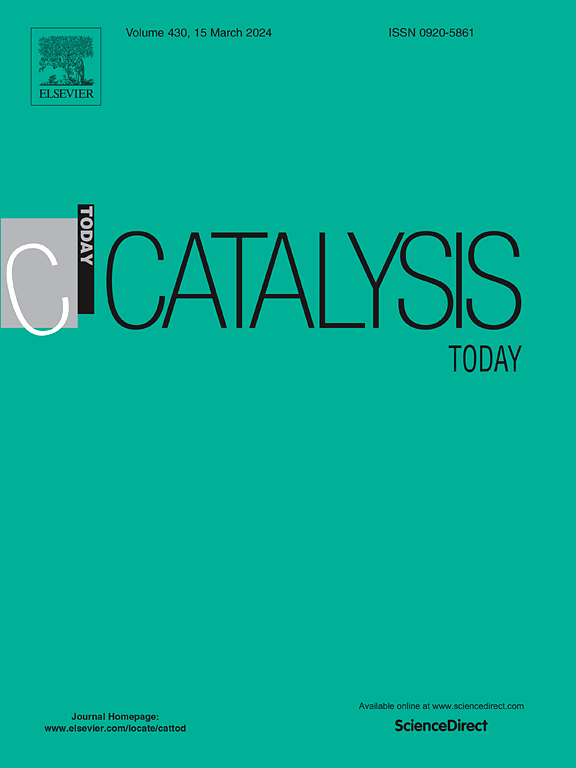Reaction pathway of NOX reduction on a MnOX-CeO2 catalyst: An in-situ FTIR study
IF 5.2
2区 化学
Q1 CHEMISTRY, APPLIED
引用次数: 0
Abstract
MnOX-CeO2 mixed oxide is a highly effective catalyst for NO reduction with NH3 in exhaust gases, demonstrating excellent NO conversion and N2 selectivity at low temperatures. However, at high temperatures, both conversion and selectivity decline, leading to increased formation of N2O and NO2. To understand this behavior, the reaction mechanism was investigated using in situ FTIR spectroscopy, which revealed two distinct pathways. At low temperatures, an Eley-Rideal mechanism dominates, where ammonia adsorbed on Lewis acid sites reacts with gas-phase NO, forming nitrosamine intermediates that rapidly decompose into N2 and H2O. At high temperatures, the Langmuir-Hinshelwood mechanism becomes predominant, involving the adsorption of both NH3 and NO, with NO undergoing oxidation to nitrate species before reacting with NH3-derived intermediates. The excessive deprotonation of adsorbed NH3 under these conditions leads to the formation of N2O as a by-product. These insights provide a deeper understanding of the temperature-dependent catalytic performance of MnOX-CeO2 in NO reduction.
MnOX-CeO2催化剂上NOX还原反应途径的原位FTIR研究
MnOX-CeO2混合氧化物是废气中NH3还原NO的高效催化剂,在低温条件下具有良好的NO转化率和N2选择性。然而,在高温下,转化率和选择性都下降,导致N2O和NO2的生成增加。为了了解这种行为,使用原位FTIR光谱研究了反应机理,揭示了两种不同的途径。在低温下,eely - rideal机制占主导地位,其中吸附在Lewis酸位点上的氨与气相NO反应,形成亚硝胺中间体,迅速分解成N2和H2O。在高温下,Langmuir-Hinshelwood机制占主导地位,涉及NH3和NO的吸附,NO在与NH3衍生的中间体反应之前被氧化成硝酸盐。在这些条件下,吸附NH3的过度去质子化导致副产物N2O的形成。这些见解为MnOX-CeO2在NO还原中的温度依赖性催化性能提供了更深入的理解。
本文章由计算机程序翻译,如有差异,请以英文原文为准。
求助全文
约1分钟内获得全文
求助全文
来源期刊

Catalysis Today
化学-工程:化工
CiteScore
11.50
自引率
3.80%
发文量
573
审稿时长
2.9 months
期刊介绍:
Catalysis Today focuses on the rapid publication of original invited papers devoted to currently important topics in catalysis and related subjects. The journal only publishes special issues (Proposing a Catalysis Today Special Issue), each of which is supervised by Guest Editors who recruit individual papers and oversee the peer review process. Catalysis Today offers researchers in the field of catalysis in-depth overviews of topical issues.
Both fundamental and applied aspects of catalysis are covered. Subjects such as catalysis of immobilized organometallic and biocatalytic systems are welcome. Subjects related to catalysis such as experimental techniques, adsorption, process technology, synthesis, in situ characterization, computational, theoretical modeling, imaging and others are included if there is a clear relationship to catalysis.
 求助内容:
求助内容: 应助结果提醒方式:
应助结果提醒方式:


